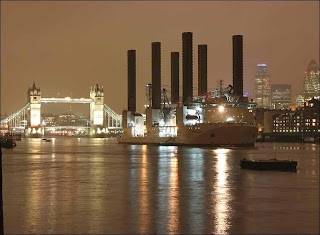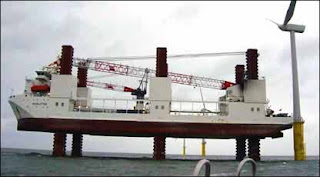 Lost in the discussions of global climate change, ongoing war in Iraq, the erupting conflict in Kenya, the tragedy in Darfur and impending recession looms what may be the most serious near-term crisis of all: the possibility of a food crisis beginning with the collapse of Mexico's agricultural system.
Lost in the discussions of global climate change, ongoing war in Iraq, the erupting conflict in Kenya, the tragedy in Darfur and impending recession looms what may be the most serious near-term crisis of all: the possibility of a food crisis beginning with the collapse of Mexico's agricultural system.
Their are a number of culprits responsible for this, but the single biggest factor is clearly the North American Free Trade Agreement (NAFTA). In his book "Making Globilzation Work" Nobel laureate Joseph Stiglitz points out that "In part, free trade has not worked because we have not tried it: trade agreements have been neither free nor fair."
Specifically with regard to Mexico he notes:
Not only did NAFTA not lead to robust growth, it can even be argued that in some ways it contributed to Mexico's poverty...A fairer trade agreement would have eliminated America's agricultural subsidies and its restrictions on imports of agricultural goods..into the United States."
I wouldn't hold my breath waiting for that to happen. (GW)
NAFTA and Mexico's Agrarian Apocalypse: Zero HourBy John Ross
CounterPunch.org
January 17, 2008
At the stroke of midnight this past January 1st, a hundred or so farmers and day laborers from both sides of the border converged on the hump of the Cordoba Las Americas bridge that connects up El Paso and Ciudad Juarez, to mark the demise of Mexican agriculture. In accordance with the timetables set by the North American Free Trade Agreement signed by Mexico, the U.S. and Canada 14 years ago, as of January 1st 2008, all tariffs on corn, beans, powdered milk, sugar and 200 agricultural products were reduced to zero, setting in motion a doomsday scenario that farmers organizations here say will inevitably lead to crisis in the Mexican "campo" or countryside, mass abandonment of unsustainable plots, increased hunger, and even armed rebellion by the nation's beleaguered small farmers.
"If they build steel walls to keep our people from entering the United States, we will make walls of people to keep their products out of Mexico," a grizzled leader of the militant farmers' front El Barzon Popular growled into his bullhorn as the protestors spread out in the frigid dark to block the lanes of the bridge over the river the U.S. calls the Rio Grande and Mexico the Rio Bravo. But traffic was slow and few trailers were lined up to ferry the thousands of tons of U.S. agricultural products that pass over the Cordoba Las Americas into Mexico every day.
Strung across the roadway, each protestor carried a letter of the alphabet in his or her hand but despite the palpable fear and loathing afoot out in the Mexican countryside as the tariffs plummet to nothing, the farmers could barely muster enough troops to spell out "Sin Maiz No Hay Pais - Y Tampoco Sin Frijol", including the appropriate spacing between words ("Without Corn, There Is No Country - And Also Without Beans.")
Despite the midnight deadline, the immediate impacts of this premeditated apocalypse may be postponed for a while - at least until the spring planting when farmers have to calculate how many hectares they can afford to put under crops. Unlike the U.S., farm subsidies are a thing of the past here, stripped away years ago in the rush to NAFTA.
Reduction to zero tariffs is not in fact a steep drop. 14 years of incremental decreases had wiped out 90% of all protectionist barriers by 2007 and U.S. corn growers were only shelling out 18% of the value of their exports to get their grain into Mexico. Moreover, NAFTA-driven dumping by lavishly subsidized U.S corn growers that allowed them to drop their loads in Mexico below cost and still make a boodle is being blunted by skyrocketing ethanol subsidies as maize climbs to record quotes on U.S. commodity markets - the grain hit an all-time record $177 USD a metric ton last spring but has begun to slide as storage capacity for ethanol corn is saturated and distribution lags far behind production.
Meanwhile, the uptick in world corn prices ripples out in the global marketplace with tortillas topping out at nine pesos the kilo on New Year's Day here - tortilla prices in Mexico have risen 126% under NAFTA from 1994 to 2007 despite - or because of - massive corn imports from the U.S. (44 million tons in the same period.) The tortilla remains the household measure for basic food prices in Mexico.
According to the World Food & Agricultural Organization or FAO, the world has only 11 weeks of consumable corn reserves left, the lowest inventory since record keeping began. Corn prices will remain unstable until producers can sort out the relationship between food cropping and biofuels, the FAO cautioned in a recent report. Low reserves and high prices are a sure formula for social upheaval, underscores the U.N. organization, pointing out that grain riots broke out in Morocco, Uzbekistan, Yemen, Guinea, Mauritania, and Senegal last year.
Despite the farmers' New Years protest on the Cordoba Bridge, the truth of the matter is that formal notice of the death of Mexican agriculture is long overdue. The damage was done long before NAFTA (or the Treaty of Free Trade With North America - TLCAN - here in Mexico) was a gleam in Ronald Reagan's eyeball. As Mexico decapitalized the "campo" following the 1982 default crisis, which allowed the World Bank and the International Monetary Fund to annex the Mexican economy and initiate "structural readjustment" of the agricultural sector, the nation ceded its nutritional sovereignty to U.S. imports.
The migration of impoverished subsistence farmers from southern Mexico that swelled the Mexico City misery belt in sprawling slums like Nezahualcoytl was the first concrete evidence of the evisceration of the "campo", ventures Harvard professor John Womack in a recent e-mail. Womack is the author of the definitive biography of Emiliano Zapata, the incorruptible farmer-general who remains emblematic of the campesinos' struggle for land.
NAFTA-TLCAN, which, after all, is an integral part of the same scheme of "structural adjustments" to globalize Mexico's agricultural sector and force dependence on export cropping, has only accelerated the stampede from the countryside and into the migration stream. By the trade treaty's 10th anniversary in 2004, NAFTA-TLCAN had driven 1.2 million farmers off the land, according to a Carnegie Endowment evaluation of the pact's impacts issued that year. Since each farm family averages out to six people, the total number of expulsees from the campo hovers around 6 million.
In 1993, just before NAFTA-TLCAN became fact, Mexico's Secretary of Agriculture contracted UCLA professor Raul Hinojosa to calculate the fallout amongst poor farmers. The researcher's worst-case scenario was the diaspora of 10 million campesinos. Now, with the reduction of NAFTA-TLCAN tariffs to zero, that "goal" is just around the corner.
Where do they go? During ex-president Vicente Fox's six year term in office, 2.4 million Mexicans, 70% of them reportedly displaced farmers, migrated to the U.S. despite the formidable barriers erected by Washington to keep them out. U.S. anti-immigration pundits like Lou Dobbs and Republican and Democratic presidential hopefuls that beat up on undocumented Mexican workers might do better to pin the tail on the correct donkey - the North American Free Trade Agreement.
According to CONAPI, Mexico's Council on Population, 29 million Mexicans and Mexican descendants now live in the United States, two million more than live out in the Mexican campo from which so many of them have fled. Ironically, those 27 million who remain on the land back home are sustained by the $22,000,000,000 USD in "remisas" that those who have gone north send back, Mexico's second source of Yanqui dollars behind $100 barrel petroleum. Which is to say the Mexican agricultural sector is supported by those who have abandoned it.
Since NAFTA-TLCAN kicked in January 1st 1994, the same night the Zapatistas rose in Chiapas to remind Washington just how desperately poor and unstable its new trading partner really was, four Mexican presidents - Carlos Salinas, Ernesto Zedillo, Vicente Fox, and now Felipe Calderon, apparently rendered dumb by Washington's dominance, have turned a deaf ear to demands by farmers' organizations to re-open the treaty-agreement's agricultural chapters for renegotiation. Indeed, leftist Andres Manuel Lopez Obrador's insistence on renegotiating NAFTA-TLCAN was a nuts and bolts factor in the campaign to deny him the presidency.
For Calderon, who was awarded high office amidst widespread fraud, NAFTA-TLCAN has been a net gain for Mexico's farmers. The president and his cohorts like Agriculture Secretary (SAGARPA) Alberto Cardenas never tire of chanting the mantra that the trade pact has nearly tripled Mexican agricultural exports to the U.S. But what these neo-liberal mouthpieces forget to point out is that Mexico has run a $2,000,000,000 USD deficit in Ag exports to the U.S. every year since the late '90s as U.S. imports overwhelm the Mexican market.
Moreover, the Calderon-Cardenas happy stats disingenuously inflate the numbers - for example, Mexican beer on its way to transnational distributors who now invest heavily in breweries south of the border, accounts for 18% of $8.5 billion USD in Ag exports to the north through October 2007.
Under NAFTA, beer is considered an agricultural export.
Nor does the President and his cronies identify who it is that is actually benefiting from the NAFTA-TLCOM boom. According to the National Farmers Confederation or CNC, a creature of the once-ruling (71 years) PRI party and once gung-ho for the trade treaty, only 2% of all Mexican producers are sharing the largesse. The other 98%, including 3.5 million corn farmers, 85% of whom grow on five hectares or less (average U.S. corn spreads are 270 acres), have no access to the NAFTA-TLCAN market whatsoever. The big winners? About 20,000 corporate tomato growers, avocado and tropical fruit moguls, and specialty crop niche market sharpies (organic coffee -but organic anything) - plus, of course, the beer barons.
Meanwhile, on the other side of the ledger, two out of the three top chicken suppliers to Mexico are U.S. headquartered - Pilgrim's Pride and Tyson. Mexico now imports 22% of its corn, 55% of its wheat (which went to zero tariff in 2003), and 72% of its rice from U.S. growers. Wal-Mart, with over 700 megastores and now the largest employer and retail food seller in the country, provides a ready-made distribution system for getting U.S. Ag products into Mexican homes. Wal-Mart, now Mexico's leading tortilla seller, is the poster boy for the NAFTA-TLCAN credo of "convergence" - selling the same product in the same stores at the same price on all sides of the border.
But if Mexico's agricultural apocalypse has already come to pass, new ones are lighting up the radar screens. The zero tariff deadline will particularly play out on southern Mexico's mid-level sugar growers, mostly "pequenos proprietarios" or "small land owners" and their huge workforces of underclass campesinos. In respect to the beloved "frijol", although Cardenas's SAGARPA insists that Mexicanos no longer eat beans and the inundation of U.S.-grown legumes will have little impact on diet, beans are an emblematic commodity which combined with maiz form a protein that has sustained the Mexican "raza" (race) since its birth.
But the most lethal blow from zero tariffs will be a speeded-up abandonment of their plots by small corn farmers and their immersion in an already-swollen migration stream, a tale that does not presage a happy ending. Traditional migration routes to The Other Side are now shut down by U.S. militarization of the border, ICE raids in U.S. Mexican communities, and the anti-Mexican hysteria sweeping that northern neighbor as the presidential campaigns peak.
With this safety valve shut off, rural youth have little option but to turn to drug cropping. "It's the only sector where there is any profit," writes National Autonomous University researcher Simon David Avila Pacheco. A hectare under poppy ("amapola") yields 11 kilos of heroin worth about $3.5 million pesos. Marijuana, which is bulkier and harder to transport, brings in about $1.7 million pesos, ten times what a campesino will make with a legitimate crop. But even drug cropping runs the risk of confronting U.S. market forces - Uncle Sam's land is swimming in cut-rate Afghani heroin, the bitter fruit of Washington's war in that devastated country, and homegrown now accounts for the bulk of marijuana reserves in El Norte.
Mexico produces no cocaine and is a "trampoline" for springboarding Colombian coke into the U.S. - NAFTA-TLCAN trade actually opened new routes for the transfer of the Colombian export across the border (the cartels went shopping for trucking firms in Juarez in late 1993.) Mexico does manufacture and export tons of methamphetamine or "speed" but that's a non-agricultural item.
Increased cropping of marijuana and amapola in the impoverished outback is guaranteed to increase militarization of the countryside. Calderon has sent 30,000 troops into the campo in a permanent war on drugs that cost 2000 Mexican lives in 2007 alone.
Violence has been pandemic in the Mexican campo ever since the European Conquest. Massacres and bloody land battles like Acteal in Chiapas (49 killed) and Rio Frio in Oaxaca (29) are contemporary expressions of the eternal war for the land here. Mexico's many guerrillas historically have incubated inside farmers' movements and still do. The Calderon-Cardenas strategy of deliberate denial of the crisis in the countryside is a little like whistling past the graveyard.
Secretary of Agriculture Alberto Cardenas, a former governor of Jalisco state, is an agro-tycoon from the central Mexican "Bajio", a fertile swatch of land from which big growers reap fortunes in export agriculture. A holdover from the Fox administration (Fox too made his fortune in Bajio export agriculture), he is a stocky, pugnacious and not very bright man who represents the right wing of the right wing PAN party, the "Yunque", a secretive Catholic cabal based in the Bajio from which Fox drew many of his cabinet members.
So when he had to sell Mexicans on the "benefits" of zero tariffs, Cardenas came up with the brilliant gimmick of getting Lorena Ochoa, the world's number one woman golfer and a Guadalajara native, to extol the health of the Mexican "campo" - an unfortunate play on words (a "campo de golf" is a golf course) - which has incited farmers' organizations to schedule a national march on Mexico City this January 31st.
For the Mexican underclass, "campos de golf" are the playgrounds of their "patrones" or bosses. 10 years ago, speculators secretly bought community land in Tepotzlan up in Zapata country in Morelos state to build a country club and golf course and began sucking up what little ground water the farmers still had left. Wild protests - the so-called "Golf War" - ensued. In the midst of flying rocks and burning construction machinery, a U.S. reporter asked the newly-elected mayor (the old one had sold out to the golfers) why the people were so agitated about a golf course. Lazaro Rodriguez paused, put his hand on the reporter's shoulder, and stared him in the eye like he was a nincompoop from Mars. "John," the exasperated mayor made it clear, "we don't play golf here."














